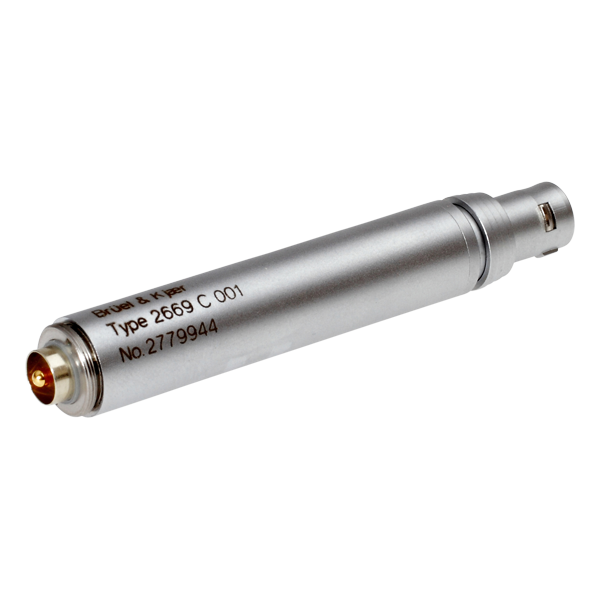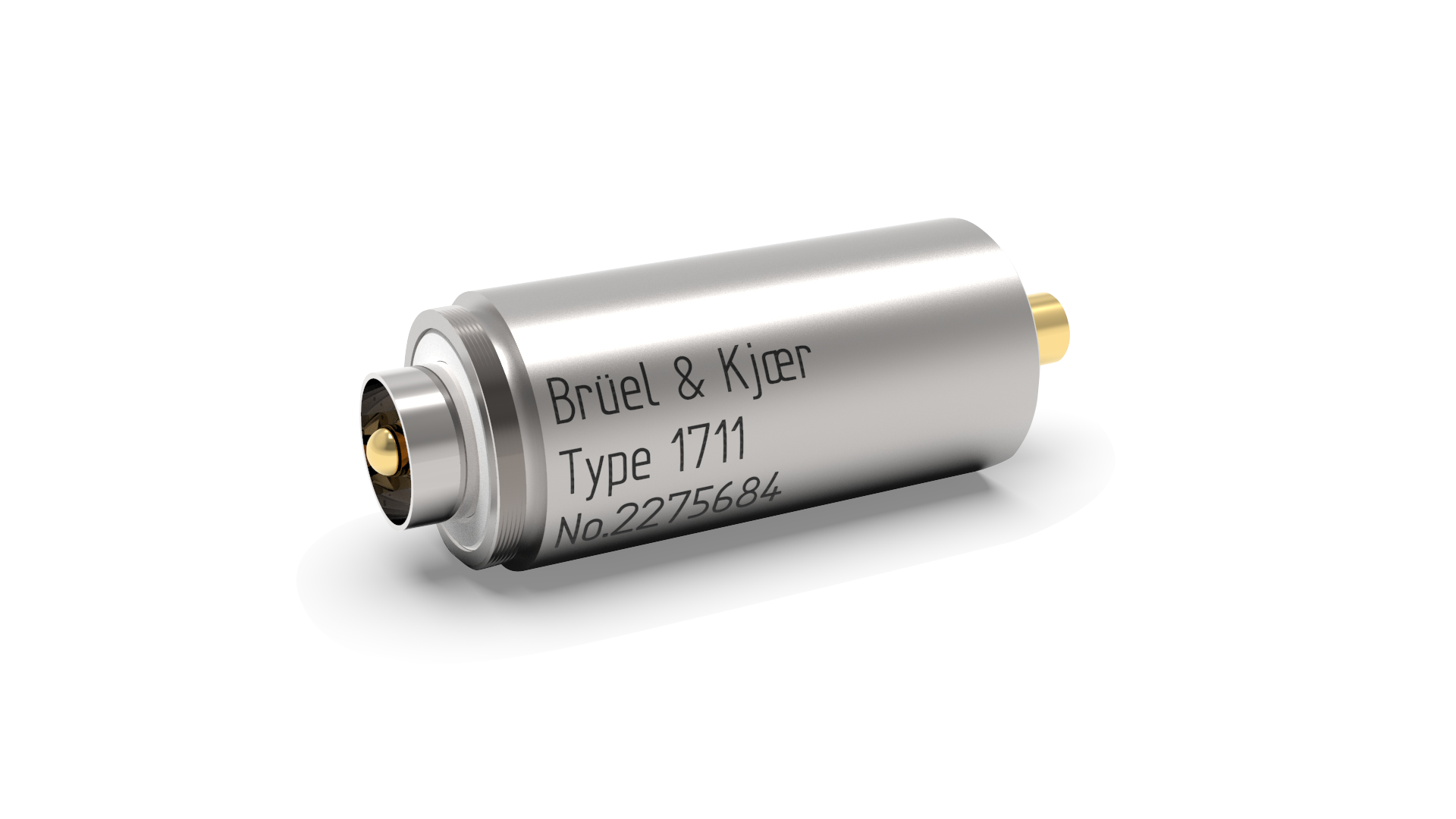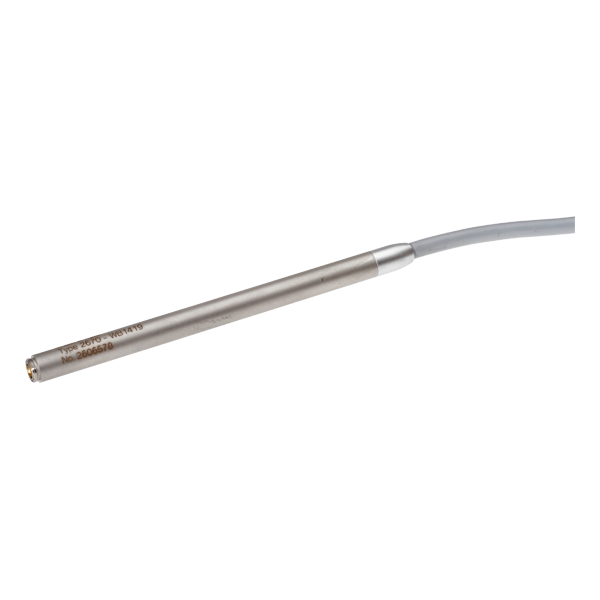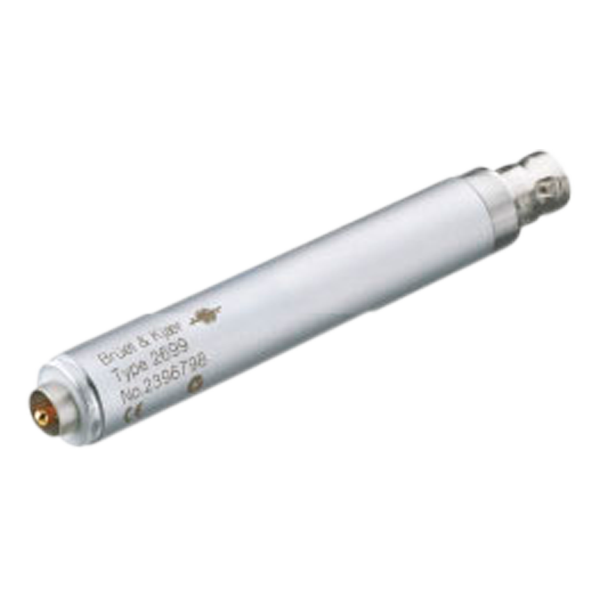PRÉ-AMPLIFICADORES DE MICROFONE
Os pré-amplificadores de microfone da Brüel & Kjær são robustos e acusticamente otimizados para uma ampla gama de condições ambientais de funcionamento. A alta capacidade de corrente de saída de nossos pré-amplificadores é capaz de conduzir os cabos extremamente longos, sem degradação de sinal - mesmo com elevados níveis de pressão sonora presentes em altas frequências. Os designs do pré-amplificador CCLD Brüel & Kjær e do clássico pré-amplificador têm dimensões de 1/2 pol. e 1/4 pol., ajustando-se aos tamanhos dos cartuchos de microfone mais usados.
What is a Preamplifier-
TIPO 1706
Pré-amplificador de microfone de alta temperatura CCLD
Designed to make acoustical measurements at temperatures up to 125°C (257°F) with a constant-current line drive (CCLD) input module.
- Optimised for : CCLD
- Connector at preamplifier : BNC
- Polarization voltage support : No
- Frequency range : <minmax min="20" max="50000" />
- Attenuation : -0.35
-
TIPO 1711
Pré-amplificador de microfone CCLD curto de ½ polegada
Permite que você faça medições acústicas em espaços confinados.
- Optimised for : Measuring in confined space
- Connector at preamplifier : SMB
- Polarization voltage support :
- Frequency range : 20 to 20000
- Attenuation : 0.2 dB (typical)
-
TIPOE 2669-B
Pré-amplificador de microfone de ½ polegada, cônico, incluindo cabo AO-0428, conector Brüel & Kjær
Projetado para operar em uma ampla faixa de temperatura, umidade e outras condições ambientais.
- Optimised for : Acoustical
- Connector at preamplifier : LEMO 0B, 7-pin
- Polarization voltage support : Yes
- Frequency range : 3 to 200000
- Attenuation : < 0.35
-
TIPO 2669-C
Pré-amplificador de microfone de ½ polegada, cilíndrico, conector LEMO 1B, sem cabo
Projetado para operar em uma ampla faixa de temperatura, umidade e outras condições ambientais
- Optimised for : Cylindrical
- Connector at preamplifier : LEMO 1B, 7-pin
- Polarization voltage support : Yes
- Frequency range : 3 to 200000
- Attenuation : < 0.35
-
TIPO 2669-L
Pré-amplificador de microfone de ½ polegada, inclinado, incl. cabo, conector LEMO de 7 pinos
Este pré-amplificador de microfone de ½ "opera em uma ampla faixa de temperatura, umidade e outras condições ambientais.
- Optimised for : Acoustical
- Connector at preamplifier : LEMO 0B, 7-pin
- Polarization voltage support : Yes
- Frequency range : 3 to 200000
- Attenuation : < 0.35
-
TIPO 2670
Pré-amplificador de microfone de ¼ de polegada, cabo integral de 2m com plugue LEMO de 7 pinos
Projetado para operar em uma ampla faixa de temperatura, umidade e outras condições ambientais.
- Optimised for : Phase
- Connector at preamplifier : Fixed (2 m)
- Polarization voltage support : Yes
- Frequency range : 15 to 200000
- Attenuation : <0.4
-
TIPO 2670-WB-1419
¼-inch microphone preamplifier, integral 2m cable with 7-pin LEMO plug
Projetado para operar em uma ampla faixa de temperatura, umidade e outras condições ambientais. Otimizado para medições de airbag.
- Optimised for : Airbag
- Connector at preamplifier : Fixed (2 m)
- Polarization voltage support : Yes
- Frequency range : 1 to 100000
- Attenuation : 11
-
TIPO 2671
Pré-amplificador de microfone CCLD para microfones pré-polarizados de 1/2 polegada, sem cabo
Projetado para ser usado em uma ampla gama de condições ambientais e em espaços estreitos.
- Optimised for : CCLD
- Connector at preamplifier : BNC
- Polarization voltage support :
- Frequency range : 20-50000
- Attenuation : <0.35
-
TIPO 2673
Pré-amplificador de microfone de ½ polegada com facilidade de tensão de inserção
Projetado para permitir a calibração de microfones condensadores de ½" e 1" pela técnica de tensão de inserção
- Optimised for :
- Connector at preamplifier : LEMO 0B, 7-pin
- Polarization voltage support : Yes
- Frequency range : 3 to 200000
- Attenuation : < 0.05
-
TIPO 2695
Pré-amplificador curto CCLD de ½ polegada
Projetado para medições acústicas com um módulo de entrada CCLD. Microfones pré-polarizados podem ser conectados ao pré-amplificador.
- Optimised for : Short CCLD
- Connector at preamplifier : 10 – 32 UNF
- Polarization voltage support :
- Frequency range : 20 to 50000
- Attenuation : < 0.2
-
TIPO 2699
CCLD, pré-amplificador de microfone com ponderação A
Projetado para eliminar perturbações de baixa frequência causadas pelo boom do corpo e pelo ruído da estrada durante medições no carro
- Optimised for : A-weighted CCLD
- Connector at preamplifier : BNC
- Polarization voltage support :
- Frequency range : A-weighted
- Attenuation : < 0.3

TABLE OF CONTENTS
1. Preamplifiers for condenser microphones
2. Classical Preamplifiers
3. CCLD Preamplifiers
4. Selecting a Preamplifier
5. Preamplifier Types
PREAMPLIFIERS FOR CONDENSER MICROPHONES
A condenser microphone must be combined with a preamplifier to provide impedance conversion, some filtering, and the capability to drive relatively long cables without significant signal degradation.
Our preamplifiers are designed in accordance with two principles, referred to as Classical Preamplifiers, and CCLD Preamplifiers. Each provide their own special set of features:
CLASSICAL PREAMPLIFIERS
The classical preamplifier has an easy to understand concept. It is basically a unity gain amplifier with extremely high input impedance and very low input capacitance.
- The supply voltage can be either ±15 V DC or a single 80 V DC.
- The output signal has its own separate wire, as do the polarization and CIC voltage.
- Pin 5 is often used for transmission of TEDS data (so called Class II TEDS).
- Charge Injection Calibration (CIC) is performed by injecting a signal on pin 1 of the LEMO connector.
CCLD Preamplifiers
Despite its origin in the vibration transducer world, the Constant Current Line Drive (CCLD) principle is increasing in popularity in the area of sound and measurement applications. Different manufacturers market transducers using the CCLD principle under different names.
The benefit of CCLD is that the same wire is used for both the signal and the supply current. Using TEDS Class I even the TEDS data can be transmitted over that same wire (using a level controlled electronic switch as shown in the figure below).
Classical vs. CCLD Preamplifier
| Classical | CCLD | |
| Output Voltage | 55 Vp | 7 Vp |
| Output Current | 2 to 20 mA | 3 to 20 mA |
| Noise | <2 µV | 4 µV |
| Distortion | ≤ 80 dB | ≤ 70 dB |
| Verification | CIC/IVC | No |
| IEEE 1451.4 | Yes | Yes |
| Cable Price | Higher | Lower |
| Connector | LEMO | BNC |
| Microphone Type | Both | Prepolarized only |
| Accelerometer Conditioning | No | Yes |
SELECTING A MICROPHONE PREAMPLIFIER
Brüel & Kjær offer a large selection of robust and acoustically optimised preamplifiers that allow operation in a wide range of environmental conditions. The high output current capability of Brüel & Kjær preamplifiers allows the use of extremely long cables, even with high sound pressure levels present at high frequencies.
- Preamplifiers are available in 1/2-inch and 1/4-inch dimensions, directly fittting with the most used cartridge sizes.
- Adaptors are available for 1-inch and 1/8-inch microphone cartridges
- The most popular classical 1/2-inch preamplifier is Type 2669. Available in several different versions.
- Type 2669 combines a CCLD preamplifier and an A-weighting filter in a single unit. The preamplifier is easily distinguished due to the two engraved rings
- When insert voltage calibration is required, Type 2673 is the obvious choice.
- Type 2695, maybe due to its small size, (half the length of the extremely popular CCLD preamplifier Type 2671), is an often overlooked unit
A CCLD input can be connected to both microphones and vibration sensors (and many other sensors with CCLD output). Due to the working principle the signal is superimposed on a DC voltage. This DC bias voltage is typically around 12 V. Bias drift (over temperature or time) will reduce the dynamic range.
Due to the lower DC supply voltage (typically 20 – 28 V DC compliance voltage out of the front-end), there is some limitation in the upper limit for a CCLD solution. Another limitation of CCLD solution is that only prepolarized microphones can be used and that CIC is not available.
This, however, in many practical applications is happily accepted to reap the benefits of CCLD: Ease of use and cheap cables!
PREAMPLIFIER TYPES AND APPLICATIONS
 |
 |
 |
 |
 |
||
| Type No. | 2669-B | 2669-L | 2669-C | 2670 | 1706 | |
| Diameter | inch | 1/2 | 1/2 | 1/2 | 1/4 | 1/2 |
| Optimized | Acoustical* | Acoustical | Cylindrical | Phase | CCLD | |
| Connector at Preamplifier | LEMO 0B, 7‐pin | LEMO 0B, 7‐pin | LEMO 1B, 7‐pin | Fixed (2 m) | BNC | |
| Connector at Instrument/Cable | B&K, 7‐pin | LEMO 1B, 7‐pin | None | LEMO 1B, 7‐pin | N/A | |
| Calibration Facility | CIC | CIC | CIC | CIC | None | |
| Polarization Voltage Support | Yes | Yes | Yes | Yes | No | |
| Supply Voltage | V | ±14 to ±60 or 28 to 120 |
±14 to ±60 or 28 to 120 |
±14 to ±60 or 28 to 120 |
±14 to ±60 or 28 to 120 |
28 |
| Max. Output Voltage (Peak) | V | 55 (5 below supply) |
55 (5 below supply) |
55 (5 below supply) |
55 (5 below supply) |
7 |
| Max. Output Current (Peak) | mA | 20 | 20 | 20 | 20 | 19 |
| Frequency Range | Hz | 3 to 200000 ±0.5 dB (15 pF) |
3 to 200000 ±0.5 dB (15 pF) |
3 to 200000 ±0.5 dB (15 pF) |
15 to 200000 ±0.5 dB (6.2 pF) |
20 to 50000 ±2 dB (12 pF) |
| Attenuation | dB | <0.35 | <0.35 | <0.35 | <0.4 | <0.35 |
| Noise A‐weighted, typical | µV | 1.9 | 1.9 | 1.9 | 4 | 4 |
| Noise 22.4 Hz to 300 kHz, typical | µV | 8.2 | 8.2 | 8.2 | 14 | 15 |
| Input Impedance | GΩ || pF | 15 || 0.3 | 15 || 0.3 | 15 || 0.3 | 15 || 0.25 | 6 || 0.5 |
| TEDS UTID | 1025 from serial number 2221155 |
1025 from serial number 2221155 |
1025 from serial number 2221155 |
1025 from serial number 2248944 |
1025 from serial number 2264319 |
 |
 |
 |
 |
 |
||
| Type No. | 2670-WB-1419 | 2671 | 2673 | 2695 | 2699 | |
| Diameter | inch | 1/4 | 1/2 | 1/2 | 1/2 | 1/2 |
| Optimized | Airbag | CCLD | Calibration | Short CCLD | CCLD | |
| Connector at Preamplifier | Fixed (2 m) cable | BNC | LEMO 0B, 7‐pin | 10–32 UNF | BNC | |
| Connector at Instrument/Cable | LEMO 1B, 7‐pin | N/A | LEMO 1B, 7‐pin | N/A | N/A | |
| Calibration Facility | None | None | IVC | 10–32 UNF | BNC | |
| Polarization Voltage Support | Yes | No | Yes | No | No | |
| Supply Voltage | V | ±14 to ±60 or 28 to 120 |
28 | ±14 to ±60 or 28 to 120 |
28 | 28 |
| Max. Output Voltage (Peak) | V | 55 (10 below supply) |
7 | 55 (10 V below supply) |
7 | 7 |
| Max. Output Current (Peak) | mA | 20 | 19 | 19 | 19 | 18 |
| Frequency Range | Hz | 1 to 100000 ±1 dB (6.2 pF) |
20 to 50000 ±2 dB (12 pF) |
3 to 200000 ±0.5 dB (20 pF) |
20 to 50000 ±2 dB (15 pF) |
A‐weighted to IEC 61672 Class 1 |
| Attenuation | dB | 11 | <0.35 | <0.05 | <0.2 | 0, ±0.3 dB at 1 kHz |
| Noise A‐weighted, typical | µV | 4 | 4 | 1.8 | 4 | 8 Max., LIN |
| Noise 22.4 Hz to 300 kHz, typical | µV | 14 | 15 | 11 | 12 | N/A |
| Input Impedance | GΩ || pF | 15 || 15 | 1.5 || 0.4 | 1 || 0.05 | 1.7 || 0.4 | 10 +20 to 40% || 0.5 |
| TEDS UTID | 1025 from serial number 2264319 |
1025 from serial number 2264319 |
No | 1025 | 1025 |
WANT TO KNOW MORE?
For further details of the range, availability, and price, please use the link below to get in touch with your local Brüel & Kjær representative.

Fale hoje com o seu representante local da Brüel & Kjær!











